Regional Logistics Industry High-Quality Development Level Measurement, Dynamic Evolution, and Its Impact Path on Industrial Structure Optimization: Finding from China
Abstract
1. Introduction
2. Dynamic Evolution and Correlation Degree of High-Quality Regional Logistics Industry Development and Industrial Structure Upgrading
2.1. Measurement and Dynamic Evolution of the High-Quality Development of the Regional Logistics Industry
2.1.1. Construct the Measurement Indicators
2.1.2. Measurement Method
2.1.3. Analysis of the Measure Results
2.2. Dynamic Evolution of High-Quality Development of Regional Logistics Industry
2.2.1. Research Methods
2.2.2. Dynamic Evolution Process
2.3. Analysis of the Dynamic Evolution Process
2.4. Grey Relational Analysis
3. The Influence Path Test of the High-Quality Development of the Chinese Regional Logistics Industry on the Industrial Structure Upgrading
3.1. Mechanism Analysis
3.1.1. Analysis of the Direct Effect of High-Quality Development of the Logistics Industry on Industrial Structure Upgrading and Its Action Mechanism
3.1.2. Regional Heterogeneity Analysis of the Influence Intensity of High-Quality Development of Logistics Industry on Industrial Structure Upgrading
3.1.3. Analysis of the Non-Linear Influence of High-Quality Development of Logistics Industry on Industrial Structure Upgrading and Its Adjustment Mechanism
3.2. Model Construction and Data Source
3.2.1. Model Construction
3.2.2. Index Description and Data Sources
3.3. Empirical Analysis
3.3.1. Analysis of the Baseline Regression Results
3.3.2. Analysis of the Threshold Regression Results
- (1)
- Test of the threshold effect
- (2)
- Analysis of threshold regression results
3.3.3. Robustness Test
4. Results and Discussion
- (1)
- The regional logistics industry’s high-quality development level and dynamic evolution process were measured and a high-quality development index system for the industry was built. The main conclusions show that most of the provinces in China effectively improved the high-quality development level of the logistics industry during the sample observation period. Most of the provinces with a relatively high level of high-quality development of the logistics industry belonged to the eastern region and most provinces with a relatively lower level of growth belonged to the western region. These findings are consistent with the results of the previous study. There was a positive correlation between logistics and economic growth, and the level of economic development determined the development level of the logistics industry to a certain extent [25,26]. Observation from the dynamic evolution process: The difference in the high-quality development level of China’s logistics industry tended to decrease and appeared to be polarized during the sample observation period. Sub-regional observation: The data in the east and west were relatively centralized and there was no polarization phenomenon, indicating that the development of different provinces in the region was relatively coordinated. The difference in the central region was also increasing and there was an obvious polarization phenomenon. On the other hand, the data in the central region were highly dispersed, indicating that the horizontal distribution in the central region was uneven and the internal difference was large. However, it can be seen from the distribution range that the wave crest in the eastern region was concentrated within 0.4, but 0.4 was the extreme value in the central region, whereas in the western region it was concentrated between 0.1 and 0.2. The overall level was the lowest among the three regions, but the level in the western region tended to increase. This may be due to the good location of the eastern region. The advantages, regional economic development, and infrastructure construction level were better, making the development of the eastern region higher than that of the other regions. To sum up, there were apparent differences in the high-quality level and evolution dynamics of logistics in the three regions, and it was found that the development of the logistics industry and regional economy were interrelated, which generally showed the unbalanced status of “high in the east and low in the west” [27].
- (2)
- The upgrading level of China’s regional industrial structure and its dynamic evolution process were measured and the grey correlation between the high-quality development of the regional logistics industry and the upgrading of industrial structure was analyzed. The findings indicate, in summary, that China’s industrial structure upgrading generally trended upward during the sample observation period, with the eastern, central, and western sub-regions ranking from high to low, respectively. This is consistent with the measurement results of Xiao et al. [28]. Observing the dynamic evolution process, it is clear that there was no polarization phenomenon despite the variations in the degree of industrial structure upgrading initially becoming smaller and then becoming greater. Sub-regional observation: The differences in the industrial structure upgrading in eastern China first increased and then decreased, and there was no polarization phenomenon. Polarization first became apparent in 2016; however, the disparity in the central region’s industrial structure upgrade level had previously been minor. The level of industrial structure upgrading in the western region generally showed an upward trend and polarization was not observed. From the perspective of grey correlation, the high-quality development of the logistics industry in each region of China had a strong correlation with the upgrading of the industrial structure and the correlations were in descending order: the western region, the eastern region, and the central region, respectively. The geographical location, economic development, personnel quality, and other production factors may have affected the process of industrial diversification. The process of industrial restructuring in the western region may not have conformed to the local development capacity due to the backwardness of various production factors [29], resulting in insufficient development momentum, which not only prevents the logistics industry from developing in a high-quality way but also prevents the industrial structure from being upgraded, making the two show a high correlation.
- (3)
- The theory put out by the theoretical analysis was confirmed, as the impact mechanism and direct influence effect of the high-quality development of China’s regional logistics industry on the upgrading of the industrial structure were examined. The conclusion shows that, first, the high-quality growth level of the logistics industry had a favorable impact on industrial transformation from the standpoint of China’s total sample level. Past research also shows that “high-quality development” can promote the “transformation and upgrading of industrial structure,” which also has particular applicability in the logistics industry [30]. Second, implementing a modern logistics system and strengthening the infrastructure are the prerequisites for achieving high-quality industrial development [31]. Therefore, this paper discussed the impact of high-quality logistics development on upgrading industrial structures. The results show that regional heterogeneity was in effect. The main reason is that the logistics industry, as a derivative industry, is largely affected by the unbalanced development of China’s regional economy, leading to regional heterogeneity of impact effects. The high-quality growth of the logistics industry in China’s eastern and central regions is having a positive influence on the modernization of the industrial structure, according to the regional regression results. The primary cause is that the infrastructure in the western region is not ideal, the economic level is low, and the high-quality development of the logistics industry is challenging and low-level, so it does not significantly contribute to the industrial structure’s modernization. As far as control variables are concerned, the effect of each region fluctuated. For example, government intervention in the eastern and western regions significantly promoted the upgrading of industrial structure, whereas it was not significantly promoted in the central region.
- (4)
- FDI plays a decisive role in the economy of developing countries such as China. It interacts with the upgrading of industrial structure and has regional heterogeneity [32,33]. Therefore, using the panel threshold model, this paper further tested the threshold effect of China’s overall sample and sub-regional samples. Based on the results, it is obvious that after the introduction of foreign direct investment exceeded the threshold value, there was no improvement in the high-quality growth level of the logistics industry that would lead to an upgrade of the industrial structure. This may be because FDI companies that have just entered the Chinese market usually adopt the form of joint ventures. As foreign-invested companies gain a deeper understanding of the local market, they tend to become sole proprietorships, and existing research indicates that with the increasing tendency of foreign-invested firms to become sole proprietorships, China’s control over the logistics industry has weakened. In the eastern and central regions, there was a threshold value, but not in the western regions, and once the level of foreign investment in the eastern region exceeded the threshold value, the positive role of the high-quality growth of the logistics industry in promoting the upgrading of the industrial structure deteriorated, whereas the central region did not have a threshold value. After the level of foreign investment crossed the threshold, the positive role of the high-quality development level of the logistics industry on the upgrading of the industrial structure changed from insignificant to significant. FDI was positive for the industrial structure, but there were regional differences in absorptive capacity [34], probably because 80% of China’s foreign investment is concentrated in the eastern region, whereas only 20% is concentrated in the central and western regions [35,36]. In addition, the scale of foreign investment introduced in the eastern region is increasing, but the quality is not high. Therefore, in enhancing FDI, we must attach great importance to guiding high-quality FDI and foreign companies to enter to improve competitiveness [37]. Despite this, the central region’s relatively low level of foreign investment may be able to positively influence the logistics industry’s rate of qualitative growth, thereby assisting in the process of modernizing the industrial structure.
5. Conclusions
Author Contributions
Funding
Data Availability Statement
Conflicts of Interest
References
- Wang, L. Policies and Practices in China’s High-Quality Development of Logistics. In Contemporary Logistics in China; Springer: Singapore, 2021; pp. 177–198. [Google Scholar]
- Yan, B.R.; Dong, Q.L.; Li, Q.; Amin, F.U.I.; Wu, J.N. A study on the coupling and coordination between logistics industry and economy in the background of high-quality development. Sustainability 2021, 13, 10360. [Google Scholar] [CrossRef]
- Zhu, X.Y. Evaluation and Prediction of High-Quality Development of Logistics Industry in China. Master’s Thesis, Beijing University of Posts and Telecommunications, Beijing, China, 2021. [Google Scholar]
- Huang, Y.; Li, Q.; Wang, X. Lean path for high-quality development of Chinese logistics enterprises based on entropy and gray models. Entropy 2019, 21, 641. [Google Scholar] [CrossRef] [PubMed]
- Gan, W.; Yao, W.; Huang, S. Evaluation of green logistics efficiency in Jiangxi Province based on Three-Stage DEA from the perspective of high-quality development. Sustainability 2022, 14, 797. [Google Scholar] [CrossRef]
- Zhou, N.; Chen, J.; Dan, B.; Zhang, W. Space time coupling and influencing factors of regional logistics and regional economy under high-quality development—Taking the Yangtze River Economic Belt as an example. Soft Sci. 2022, 1–15. Available online: http://kns.cnki.net/kcms/detail/51.1268.g3.20220721.1114.006.html (accessed on 1 August 2022).
- Li, X.B. Correlation between Modern Logistics in Upgrading of Industrial Structure. Logist. Technol. 2013, 32, 198–200. [Google Scholar]
- Liu, J.; Li, S.; Zhou, Y. Research on the dynamic relationship between industrial structure adjustment and the development level of modern logistics industry. Hacet. J. Math. Stat. 2018, 47, 1742–1753. [Google Scholar] [CrossRef]
- Gao, Y.; Chang, D.; Fang, T.; Luo, T. The correlation between logistics industry and other industries: An evaluation of the empirical evidence from China. Asian J. Shipp. Logist. 2018, 34, 27–32. [Google Scholar] [CrossRef]
- Shevchenko, D.A.; Zhao, W.; Fomicheva, E.V.; Chen, W.; Wang, Y. The Role of Smart Logistics in the China’s Industrial Structure Upgrading. In Proceedings of the International Scientific and Practical Conference Operations and Project management: Strategies and trends (DITEM 2021), Moscow, Russia, 2–4 November 2021. [Google Scholar]
- Liu, R.; Li, D. Research on the coupling and coordination between industrial structure and logistics competitiveness. Int. J. Front. Soc. 2019, 1, 43–54. [Google Scholar]
- Wang, Y. Effect of FDI in the Logistics Industry on Industrial Structure. Trans. Corp. Rev. 2011, 3, 87–95. [Google Scholar] [CrossRef]
- Saidi, S.; Mani, V.; Mefteh, H.; Shahbaz, M.; Akhtar, P. Dynamic linkages between transport, logistics, foreign direct Investment, and economic growth: Empirical evidence from developing countries. Transp. Res. Part A Policy Prac. 2020, 141, 277–293. [Google Scholar] [CrossRef]
- Feng, T.; Liang, Y.J. Study on FDI Threshold Effect of Economic Growth in Logistics Industry in China. Stat. Inf. Forum 2015, 30, 49–55. [Google Scholar]
- Wang, Z.W. Effect of FDI on the Development of Logistics Industry in Guangxi Beibu Gulf Economic Zone. Master’s Thesis, Beibu Gulf University, Qinzhou, China, 2021. [Google Scholar]
- An, T.H.T.; Yeh, K.C. Growth effect of foreign direct investment and financial development: New insights from a threshold approach. J. Dev. Econ. 2020, 23, 144–162. [Google Scholar] [CrossRef]
- Thang, T.T.; Pham, H.; Barnes, B.R. Spatial spillover effects from foreign direct investment in Vietnam. J. Dev. Stud. 2016, 52, 1431–1445. [Google Scholar] [CrossRef]
- Su, J.; Su, K.; Wang, S. Does the digital economy promote industrial structural upgrading? —A test of mediating effects based on heterogeneous technological innovation. Sustainability 2021, 13, 10105. [Google Scholar] [CrossRef]
- He, D.; Yang, J.; Wang, Z.; Li, W. Has the manufacturing policy helped to promote the logistics industry? PLoS ONE 2020, 15, e0235292. [Google Scholar] [CrossRef]
- Shi, B. China’s Regional Economic Development since 1949: Review and Outlook. China Econ. 2019, 14, 66–95. [Google Scholar]
- Zheng, Y. Foreign direct investment in China. Handbook on the International Political Economy of China; Edward Elgar Publishing: Cheltenham, UK, 2019; pp. 61–75. [Google Scholar]
- Xia, Y.; Zhang, M.; Song, Z.; Li, J.; Wu, W. The Impact of OFDI Reverse Technology Spillover Effect on Industrial Structure Upgrading; Springer: Singapore, 2020; pp. 367–380. [Google Scholar]
- Wang, H.; Zhong, X. An empirical study on the impact of china’s ofdi on the industrial structure upgrading of countries along the belt and road and the threshold effect of infrastructure levels. Singap. Econ. Rev. 2021, 1–41. [Google Scholar] [CrossRef]
- Jahanger, A. Influence of FDI characteristics on high-quality development of China’s economy. Environ. Sci. Pollut. Res. 2021, 28, 18977–18988. [Google Scholar] [CrossRef]
- Tang, X.; Wang, G. Design and analysis of e-commerce and modern logistics for regional economic integration in wireless networks. EURASIP J. Wirel. Commun. Netw. 2020, 2020, 1–15. [Google Scholar] [CrossRef]
- Zhang, C. Research on the economical influence of the difference of regional logistics developing level in China. J. Ind. Integr. Manag. 2020, 5, 205–223. [Google Scholar] [CrossRef]
- Ran, W.; Liu, R.; Liu, S. Area Differences in Regional Logistics Efficiency and the Law Governing Its Temporal and Spatial Evolution. J. Adv. Transp. 2022, 2022, 3596524. [Google Scholar] [CrossRef]
- Xiao, W.E.N.; Pan, J.D.; Liu, L.Y. China’s industrial structure upgrade in the “New Normal”: Empirical test and determinants. Singap. Econ. Rev. 2018, 63, 1037–1058. [Google Scholar] [CrossRef]
- He, C.; Yan, Y.; Rigby, D. Regional industrial evolution in China. Pap. Reg. Sci. 2018, 97, 173–198. [Google Scholar] [CrossRef]
- Han, M.L. Research on the Transformation and Upgrading of China’s Economic and Industrial Structure under the Background of High Quality Development. Master’s Thesis, Jilin University, Changchun, China, 2021. [Google Scholar]
- Yu, Y.; Duan, S.; Lin, B. High quality development of China’s industry under the new development pattern: Practical difficulties and policy guidance. Macro Qual. Res. 2021, 9, 78–98. [Google Scholar]
- Chen, H.; Pan, J.; Xiao, W. Chinese outward foreign direct investment and industrial upgrading from the perspective of differences among countries. China World Econ. 2020, 28, 1–28. [Google Scholar] [CrossRef]
- Wang, M.L.; Pang, S.L.; Wang, F.; Guo, X.; He, Z.X. Dynamic interaction between outward foreign direct investment and home country industrial upgrading: Regional differences in China. Growth Chang. 2021, 52, 2293–2317. [Google Scholar] [CrossRef]
- Jiang, M.; Luo, S.; Zhou, G. Financial development, OFDI spillovers and upgrading of industrial structure. Technol. Forecast. Soc. Chang. 2020, 155, 119974. [Google Scholar] [CrossRef]
- Wang, X.D. Research on the Threshold Effect of FDI on China’s Economic Growth. Master’s Thesis, Shandong University, Jinan, China, 2017. [Google Scholar]
- Cui, L.; Fan, D.; Li, Y.; Choi, Y. Regional competitiveness for attracting and retaining foreign direct investment: A configurational analysis of Chinese provinces. Reg. Stud. 2020, 54, 692–703. [Google Scholar] [CrossRef]
- Fan, W.; Hao, Y. An empirical research on the relationship amongst renewable energy consumption, economic growth and foreign direct investment in China. Renew. Energy 2020, 146, 598–609. [Google Scholar]
- Park, S. Quality of transport infrastructure and logistics as a source of comparative advantage. Transp. Policy 2020, 99, 54–62. [Google Scholar] [CrossRef]








| Primary Indicators | Secondary Indicators | Unit of Measurement |
|---|---|---|
| The level of innovation and development of the logistics industry | R&D funding ) | RMB 100 million |
| Number of employees in the logistics industry ) | 10,000 people | |
| Number of patent inventions granted ) | Item | |
| The level of coordinated development of the logistics industry | Value added of the logistics industry as a percentage of GDP ) | % |
| Proportion of the output value of the logistics industry in the tertiary sector ) | % | |
| The level of green development of the logistics industry | Logistics industry energy consumption ) | Million tons |
| Urban-greening coverage ) | % | |
| The level of shared development of the logistics industry | Postal mileage ) | 10,000 km |
| Fixed Internet users ) | 10,000 households | |
| Road-car ownership ) | Million units | |
| Railroad and road mileage ) | Kilometers | |
| The level of open development of the logistics industry | Import and export investment ) | Billion |
| Amount of foreign direct investment ) | Billion | |
| Regional economic development level | Regional GDP ) | RMB 100 million |
| The level of consumption of the population ) | RMB | |
| GDP growth rate ) | % | |
| Retail sales of social consumer goods ) | RMB 100 million |
| Province | 2013 | 2014 | 2015 | 2016 | 2017 | 2018 | 2019 | 2020 |
|---|---|---|---|---|---|---|---|---|
| Beijing | 0.507 | 0.520 | 0.503 | 0.492 | 0.490 | 0.494 | 0.430 | 0.417 |
| Shanghai | 0.425 | 0.444 | 0.451 | 0.451 | 0.424 | 0.455 | 0.472 | 0.449 |
| Tianjin | 0.215 | 0.229 | 0.303 | 0.187 | 0.232 | 0.216 | 0.278 | 0.311 |
| Chongqing | 0.159 | 0.176 | 0.264 | 0.178 | 0.224 | 0.239 | 0.451 | 0.463 |
| Heilongjiang | 0.154 | 0.163 | 0.275 | 0.155 | 0.201 | 0.246 | 0.198 | 0.190 |
| Jilin | 0.140 | 0.144 | 0.209 | 0.139 | 0.183 | 0.196 | 0.170 | 0.200 |
| Liaoning | 0.318 | 0.305 | 0.293 | 0.217 | 0.247 | 0.280 | 0.257 | 0.247 |
| Jiangsu | 0.649 | 0.664 | 0.651 | 0.694 | 0.61 | 0.668 | 0.584 | 0.561 |
| Shandong | 0.471 | 0.494 | 0.541 | 0.510 | 0.516 | 0.557 | 0.472 | 0.454 |
| Anhui | 0.228 | 0.242 | 0.322 | 0.269 | 0.305 | 0.328 | 0.304 | 0.318 |
| Hebei | 0.245 | 0.247 | 0.345 | 0.249 | 0.307 | 0.367 | 0.348 | 0.368 |
| Henan | 0.255 | 0.275 | 0.338 | 0.295 | 0.337 | 0.361 | 0.380 | 0.391 |
| Hunan | 0.216 | 0.228 | 0.298 | 0.236 | 0.284 | 0.319 | 0.322 | 0.316 |
| Hubei | 0.228 | 0.245 | 0.305 | 0.256 | 0.287 | 0.342 | 0.327 | 0.305 |
| Jiangxi | 0.196 | 0.216 | 0.279 | 0.243 | 0.269 | 0.277 | 0.255 | 0.279 |
| Shaanxi | 0.174 | 0.184 | 0.233 | 0.188 | 0.218 | 0.238 | 0.239 | 0.244 |
| Shanxi | 0.151 | 0.14 | 0.222 | 0.136 | 0.194 | 0.228 | 0.244 | 0.253 |
| Sichuan | 0.261 | 0.273 | 0.349 | 0.289 | 0.338 | 0.378 | 0.712 | 0.694 |
| Qinghai | 0.105 | 0.114 | 0.169 | 0.083 | 0.118 | 0.145 | 0.130 | 0.162 |
| Hainan | 0.082 | 0.119 | 0.192 | 0.134 | 0.176 | 0.240 | 0.181 | 0.177 |
| Guangdong | 0.867 | 0.857 | 0.713 | 0.869 | 0.610 | 0.649 | 0.825 | 0.747 |
| Guizhou | 0.127 | 0.141 | 0.285 | 0.138 | 0.192 | 0.288 | 0.242 | 0.219 |
| Zhejiang | 0.445 | 0.475 | 0.534 | 0.517 | 0.491 | 0.501 | 0.443 | 0.424 |
| Fujian | 0.222 | 0.235 | 0.328 | 0.265 | 0.305 | 0.367 | 0.297 | 0.267 |
| Gansu | 0.102 | 0.133 | 0.154 | 0.157 | 0.146 | 0.172 | 0.189 | 0.194 |
| Yunnan | 0.154 | 0.158 | 0.217 | 0.162 | 0.198 | 0.235 | 0.245 | 0.249 |
| Inner Mongolia | 0.157 | 0.166 | 0.231 | 0.159 | 0.356 | 0.246 | 0.208 | 0.273 |
| Ningxia | 0.090 | 0.108 | 0.225 | 0.105 | 0.166 | 0.190 | 0.165 | 0.192 |
| Tibet | 0.121 | 0.125 | 0.205 | 0.099 | 0.149 | 0.237 | 0.191 | 0.173 |
| Xinjiang | 0.126 | 0.138 | 0.206 | 0.129 | 0.160 | 0.225 | 0.192 | 0.247 |
| Guangxi | 0.146 | 0.150 | 0.230 | 0.159 | 0.199 | 0.236 | 0.249 | 0.217 |
| Province | Industrial Structure Upgrade Level | Province | Industrial Structure Upgrade Level |
|---|---|---|---|
| Beijing | 2.810 | Shanxi | 2.448 |
| Shanghai | 2.668 | Sichuan | 2.339 |
| Tianjin | 2.528 | Qinghai | 2.254 |
| Chongqing | 2.404 | Hainan | 2.304 |
| Heilongjiang | 1.946 | Guangdong | 2.466 |
| Jilin | 2.317 | Guizhou | 2.310 |
| Liaoning | 2.382 | Zhejiang | 2.466 |
| Jiangsu | 2.431 | Fujian | 2.339 |
| Shandong | 2.384 | Gansu | 2.394 |
| Anhui | 2.291 | Yunnan | 2.302 |
| Hebei | 2.31 | Inner Mongolia | 2.336 |
| Henan | 2.302 | Ningxia | 2.373 |
| Hunan | 2.368 | Tibet | 2.427 |
| Hubei | 2.320 | Xinjiang | 2.294 |
| Jiangxi | 2.304 | Guangxi | 2.243 |
| Shaanxi | 2.317 |
| Sample | Correlation |
|---|---|
| Eastern China | 0.64 |
| Central China | 0.61 |
| Western China | 0.7 |
| Variable Type | Variable Name | Variable Symbols | Variable Definition |
|---|---|---|---|
| Explained variables | Industrial structure upgrading index | INDU | |
| Explained variables | High-quality development level of the logistics industry | LOG | The comprehensive evaluation method of entropy-weight TOPSIS is used |
| Explained variables | Foreign direct investment | FDI | FDI/regional GDP |
| The amount of labor | LAB | Natural logarithm of the number of people employed | |
| Technology investment | TEC | R&D funding/regional GDP | |
| Government intervention | GOV | Government fiscal expenditure/regional GDP | |
| Investment level | PRO | Fixed-asset investment/regional GDP |
| Sample | Total Sample from China | East | Central | West |
|---|---|---|---|---|
| Variables | INDU | INDU | INDU | INDU |
| LOG | 0.214 *** | 0.233 * | 0.600 ** | 0.109 |
| (3.61) | (2.09) | (2.52) | (1.07) | |
| FDI | −0.167 | −1.310 *** | −10.058 ** | 0.017 |
| (−0.57) | (−3.15) | (−2.33) | (0.70) | |
| LAB | 0.073 * | 0.134 | −0.078 | 0.033 |
| (1.91) | (1.31) | (−1.51) | (0.12) | |
| TEC | 11.919 *** | −0.919 | 1.057 | 11.070 ** |
| (3.01) | (−0.88) | (1.38) | (2.92) | |
| GOV | 0.685 *** | 1.484 *** | 0.813 | 0.391 * |
| (2.84) | (5.60) | (1.37) | (1.92) | |
| PRO | −0.051 | −0.144 | 0.115 ** | −0.006 |
| (−1.42) | (−1.68) | (2.66) | (−0.17) | |
| _cons | 1.438 *** | 1.193 | 2.729 *** | 1.819 |
| (5.83) | (1.47) | (6.74) | (0.95) | |
| N | 248.000 | 96.000 | 72.000 | 80.000 |
| 0.408 | 0.574 | 0.595 | 0.446 |
| Region | Number of Thresholds | F-Value | p-Value | Number of BS | Threshold | ||
|---|---|---|---|---|---|---|---|
| 10% | 5% | 1% | |||||
| National | Single threshold | 53.12 *** | 0.0000 | 300 | 19.1727 | 23.2492 | 31.2513 |
| Double threshold | 7.10 | 0.6967 | 300 | 61.2730 | 74.8125 | 90.4624 | |
| Eastern region | Single threshold | 14.83 ** | 0.0367 | 300 | 10.8649 | 13.4563 | 24.9269 |
| Double threshold | 11.79 | 0.2433 | 300 | 16.4968 | 18.7317 | 24.2929 | |
| Central region | Single threshold | 15.61 * | 0.0933 | 300 | 15.2375 | 19.4040 | 22.9978 |
| Double threshold | 5.20 | 0.6700 | 300 | 25.9261 | 42.3264 | 58.2836 | |
| Western region | Single threshold | 10.15 | 0.2100 | 300 | 12.1122 | 15.5513 | 20.5402 |
| Double threshold | 14.01 | 0.1700 | 300 | 18.1960 | 26.1658 | 36.8142 | |
| Region | Number of Thresholds | Estimated Value | Confidence Interval |
|---|---|---|---|
| National | Single threshold | 0.0567 | [0.0493, 0.0750]. |
| Eastern region | Single threshold | 0.0191 | [0.0174, 0.0209]. |
| Central region | Single threshold | 0.0196 | [0.0187, 0.0198] |
| Western region | None | None | None |
| Variables | Coefficient | |||||
|---|---|---|---|---|---|---|
| Overall China Sample | Eastern China Sample | Central China Sample | ||||
| LOG | FDI ≤ 0.0567 | FDI > 0.0567 | FDI ≤ 0.0191 | FDI > 0.0191 | FDI ≤ 0.0191 | FDI > 0.0191 |
| 0.240 *** | −0.193 ** | 0.392 *** | 0.309 *** | 0.220 | 0.473 *** | |
| (−4.52) | (−2.43) | (4.10) | (3.64) | (1.35) | (3.29) | |
| GOV | 0.728 *** | 1.635 *** | 0.905 ** | |||
| (5.05) | (5.26) | (2.36) | ||||
| PRO | 0.009 | −0.219 *** | 0.093 *** | |||
| (0.46) | (−4.71) | (2.89) | ||||
| LAB | 0.082 ** | 0.141 * | −0.047 | |||
| (2.14) | (1.91) | (−0.81) | ||||
| TEC | 11.247 *** | 0.214 | 0.833 | |||
| (6.09) | (0.16) | (1.53) | ||||
| FDI | 0.154 *** | −0.879 ** | −12.879 *** | |||
| (2.69) | (−3.48) | (−4.29) | ||||
| Sample | (National) | (Eastern Region) | (Central Region) | (Western Region) |
|---|---|---|---|---|
| Variables | INDU | INDU | INDU | INDU |
| LOG | 0.493 ** | 0.983 * | 1.111 | 0.280 |
| (2.43) | (1.87) | (1.76) | (0.62) | |
| FDI | −0.195 | −3.431 | −12.058 | 1.033 *** |
| (−0.14) | (−1.47) | (−0.64) | (2.68) | |
| LAB | 0.082 | 0.689 | −0.535 ** | 0.031 |
| (0.38) | (0.93) | (−2.32) | (0.43) | |
| TEC | 28.593 | −6.406 | 0.150 | −0.210 |
| (1.61) | (−1.53) | (0.04) | (−1.34) | |
| GOV | 5.149 *** | 9.985 *** | 10.261 *** | −0.028 |
| (3.51) | (4.74) | (4.99) | (−0.35) | |
| PRO | −0.416 * | −1.432 ** | −0.027 | 38.340 ** |
| (−1.86) | (−3.09) | (−0.12) | (2.10) | |
| _cons | −1.001 | −4.997 | 2.880 | 0.593 |
| (−0.70) | (−0.85) | (1.61) | (1.19) | |
| N | 248.000 | 96.000 | 72.000 | 80.000 |
| r2 | 0.389 | 0.631 | 0.780 | 0.446 |
Publisher’s Note: MDPI stays neutral with regard to jurisdictional claims in published maps and institutional affiliations. |
© 2022 by the authors. Licensee MDPI, Basel, Switzerland. This article is an open access article distributed under the terms and conditions of the Creative Commons Attribution (CC BY) license (https://creativecommons.org/licenses/by/4.0/).
Share and Cite
Chen, H.; Zhang, Y. Regional Logistics Industry High-Quality Development Level Measurement, Dynamic Evolution, and Its Impact Path on Industrial Structure Optimization: Finding from China. Sustainability 2022, 14, 14038. https://doi.org/10.3390/su142114038
Chen H, Zhang Y. Regional Logistics Industry High-Quality Development Level Measurement, Dynamic Evolution, and Its Impact Path on Industrial Structure Optimization: Finding from China. Sustainability. 2022; 14(21):14038. https://doi.org/10.3390/su142114038
Chicago/Turabian StyleChen, Heng, and Yan Zhang. 2022. "Regional Logistics Industry High-Quality Development Level Measurement, Dynamic Evolution, and Its Impact Path on Industrial Structure Optimization: Finding from China" Sustainability 14, no. 21: 14038. https://doi.org/10.3390/su142114038
APA StyleChen, H., & Zhang, Y. (2022). Regional Logistics Industry High-Quality Development Level Measurement, Dynamic Evolution, and Its Impact Path on Industrial Structure Optimization: Finding from China. Sustainability, 14(21), 14038. https://doi.org/10.3390/su142114038






